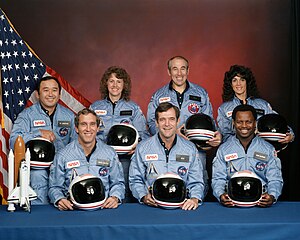 Twenty-five years ago this very morning (at age 6) I was sitting on a tile floor in the hallway of Martin Elementary School in Seekonk, Massachusetts watching history unfold in real-time. This school assembly followed a series of classroom lessons about space – our solar system, the moon, and exploration.
Twenty-five years ago this very morning (at age 6) I was sitting on a tile floor in the hallway of Martin Elementary School in Seekonk, Massachusetts watching history unfold in real-time. This school assembly followed a series of classroom lessons about space – our solar system, the moon, and exploration.  Image via WikipediaThere was a look of horror embedded on the faces of our teachers at the assembly, and confusion amongst the kids…the implications of death just don’t penetrate a youthful innocence.
Image via WikipediaThere was a look of horror embedded on the faces of our teachers at the assembly, and confusion amongst the kids…the implications of death just don’t penetrate a youthful innocence.This NASA tragedy echoed the halls of my school – the extent of my far-reaching world – for months. To be honest, until reading about the Challenger anniversary this morning, I probably never gave the incident another thought. Today, however, the broader implications of such a tragedy resonate loudly amongst a much larger adult world, especially given my chosen professional path.
Regardless of the billions of dollars spent on NASA-level engineering on all aspects of manned space exploration, there remains a degree of risk – likewise for ocean exploration (in fact the synonymy runs deep with the Challenger Shuttle being named after the HMS Challenger oceanographic voyage of 1872). Though, understanding the risk of exploration should bring an appreciation that the efforts are not ‘risky’.Risk managers can analyze this inside and out, but when it comes time for lift off, or that deep descent, no amount of training, knowledge, or technology ever accounts for all of it. While this risk is perceived as the foremost danger in exploration, it is also the excitement – that is the seeking out of an unknown time, space, and having that experience – and is a fundamental driver inherent in human nature.
The risk of exploration is not something that we dwell on before a mission, in fact its far from. Rather the risks are embedded in our subconscious and help guide us through minimizing human-factored margins of error to keep the engineers and risk manages back on terra firma confident that all is going ‘according to plan’. However, even when people do everything right, there is an element of both faith and fate that cannot be calculated, and this is understood at deep levels for all of those who have been there.
Today, I encourage you to lend some time to thinking about the Challenger crew members who died January 28, 1986 – Ellison S. Onizuka, Sharon Christa McAuliffe, Greg Jarvis, Judy Resnik, Mike Smith, Dick Scobee, and Ron McNair. Their efforts should be celebrated, as they left all preconceived notions of risk behind to take steps towards improving our body of knowledge here on Earth, and beyond, and for the benefit of all of us.
Reference
Steven J. Dick and Keith Cowing (2008). Proceedings from the NASA Administrator’s Symposium Risk and Exploration: Earth, Sea and the Stars. DOI: NASA SP-2005-4701
Related articles
- City Still Mourning 25 Years After Challenger Explosion – Fox News (news.google.com)
- Space Shuttle Challenger Disaster FAQ: What Went Wrong (space.com)
- Challenger remembered (bbc.co.uk)
- Obama Honors Astronauts Lost in Space Exploration (space.com)
- NASA to Mark Space Tragedy Anniversaries (cbsnews.com)
- How the Challenger Tragedy Gripped the Nation: A ‘Perfect Storm’ of Events (politicsdaily.com)


